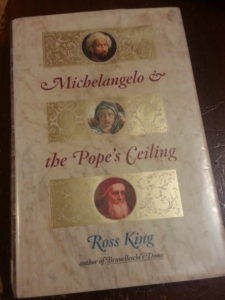 Born in Florence at the beginning of the Italian Renaissance on March 6, 1475 when “Mercury and Venus were in the house of Jupiter,” [1] Michelangelo di Lodovico Buonarroti Simoni seemed destined to become a famous in the arts. And as fortune had it, he was able to study at the famed Garden of San Marco started by the famous patron of the arts, Lorenzo de’ Medici.[2] Michelangelo’s skill as a sculptor soon became apparent with him creating “two extraordinary bas-reliefs, the Madonna of the Steps and the Battle of the Centaurs”[3] by the age of fifteen or sixteen as noted by Thomas Cahill. However it wasn’t sculpting that would propel him into the realm of the uber famous, but rather it would be his skill with a paint brush that would set him apart. The canvas for his art, as the fates would have it, was a box-shaped chapel in Rome whose foundation was laid a mere two years before his birth.[4]
Born in Florence at the beginning of the Italian Renaissance on March 6, 1475 when “Mercury and Venus were in the house of Jupiter,” [1] Michelangelo di Lodovico Buonarroti Simoni seemed destined to become a famous in the arts. And as fortune had it, he was able to study at the famed Garden of San Marco started by the famous patron of the arts, Lorenzo de’ Medici.[2] Michelangelo’s skill as a sculptor soon became apparent with him creating “two extraordinary bas-reliefs, the Madonna of the Steps and the Battle of the Centaurs”[3] by the age of fifteen or sixteen as noted by Thomas Cahill. However it wasn’t sculpting that would propel him into the realm of the uber famous, but rather it would be his skill with a paint brush that would set him apart. The canvas for his art, as the fates would have it, was a box-shaped chapel in Rome whose foundation was laid a mere two years before his birth.[4]
The journey from sculptor to painter was not an easy one for Michelangelo. Rather it was a journey full of political upheavals, family drama, personal rivalry, and four long years perched on a scaffold bend backward staring at a ceiling. In his book Michelangelo & the Pope’s Ceiling, Ross King weaves these complex issues together into a single story showing how Pope Julius II pushed Michelangelo beyond his comfort zone and into the history books.
Like most people I had heard about Michelangelo’s paintings on the vault of the Sistine Chapel and even seen replicates of famed Creation of Adam fresco. However my knowledge of these amazing paintings did not extent beyond simply recognizing their existence in the world. King’s book was a ray of sunlight into the darkness of my ignorance, bringing with it the understanding that the context surrounding the creation of a piece of art is just as important as the piece itself. This realization may sound simple as it is a common method of exegesis for literature, especially the Scriptures. Yet I must admit that before reading King’s book I had never considered studying the cultural and history context of a piece of art.
Though it was not the topic of the book, King did provide some crucial information about the cultural and political context of the Protestant Reformation. Pope Julius II steadfast focus on recovering control over the Papal States, for example, was new information previously unknown to me. Similar to some of the cardinals of the day, I was “thunderstruck” that the “vicar of Christ” would personally “lead an army into battle.” [5] Add sexual misdeeds to this tragedy misinterpretation of the role of the church in the world and it is no small wonder that Martin Luther would say that “Rome was the seat of the devil and the pope worse than the Ottoman sultan.”[6]
In closing I have to admit that while Ross King’s book Michelangelo & the Pope’s Ceiling was outside my typical reading patterns, it proved itself to be a valuable text. Ross King does a great job painting a picture of why Michelangelo is considered one of the great Renaissance painters and sculptors. Somehow this gentleman managed to capture the “expressive possibilities of the human form” [7] in a way that no one else had ever done before while working in an unfamiliar medium in the midst of a city full of political upheaval and human indecency. Writer and Episcopal priest Ian Cron once stated that “artists help people to see or hear beyond the immediate to the eternal.”[8] Perhaps this is why Sir Joshua Reynolds described Michelangelo’s work on the Sistine Chapel as “the language of the Gods”[9]
End Notes
[1] Ross King. Michelangelo & the Pope’s Ceiling (New York: Walker & Company, 2003), 1.
[2] Ross King. Michelangelo & the Pope’s Ceiling, 2.
[3] Thomas Cahill. Heretics and Heroes: How Renaissance Artists and Reformation Priests Created Our World (New York: Nan A. Talese, 2013), 111.
[4] “Sistine Chapel,” Wikipedia, The Free Encyclopedia, accessed December 19, 2017, https://en.wikipedia.org/w/index.php?title=Sistine_Chapel&oldid=810499765.
[5] Ross King. Michelangelo & the Pope’s Ceiling, 34.
[6] Ross King. Michelangelo & the Pope’s Ceilingg, 217.
[7] Ross King. Michelangelo & the Pope’s Ceiling, 299.
[8] Ian Morgan Cron. Chasing Francis: A Pilgrim’s Tale (Grand Rapids, Michigan: Zondervan, 2013), 110.
[9] Ross King. Michelangelo & the Pope’s Ceiling, 313.

 Written in the style of wisdom literature with a “delicate balance of fiction and nonfiction,”
Written in the style of wisdom literature with a “delicate balance of fiction and nonfiction,”